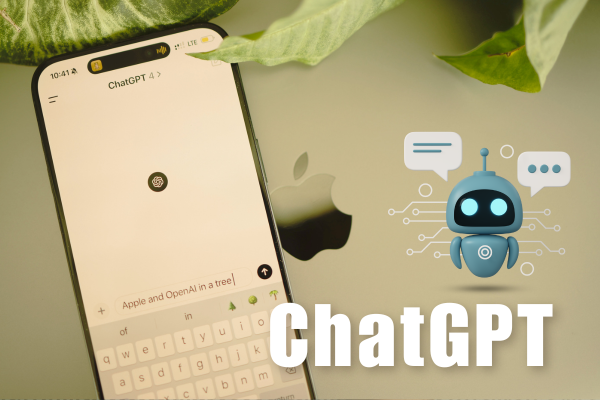
Artificial Intelligence (AI) has steadily reshaped the way we interact with technology, and at the forefront of this revolution is ChatGPT-4. As the latest iteration in a series of groundbreaking language models, ChatGPT-4 marks a significant leap in human-AI communication. This article explores how ChatGPT-4 is transforming our digital conversations, the technological advancements behind it, its real-world applications, and the ethical considerations that accompany its use. In doing so, we delve into why ChatGPT-4 is being heralded as AI’s next big leap in human interaction.
Table of Contents
Toggle1. The Evolution of ChatGPT: A Brief Overview
The journey of ChatGPT began with earlier versions that showcased the potential of AI-powered text generation. Each successive model has been built upon the foundation laid by its predecessors, incorporating advances in natural language processing (NLP), machine learning, and deep neural network architectures. ChatGPT-4 represents the culmination of years of research and development, combining enhanced language understanding with more nuanced human-like responses.
1.1 From GPT-2 to GPT-4
The progression from GPT-2 through GPT-3 to ChatGPT-4 illustrates the rapid advancements in AI language models. While GPT-2 was impressive in its ability to generate coherent text, GPT-3 raised the bar with its extensive training data and improved contextual awareness. ChatGPT-4 builds on these strengths by refining its conversational abilities, understanding more complex queries, and providing more accurate, contextually relevant responses. This evolution not only signifies technical progress but also a deeper understanding of human communication patterns.
2. Underlying Technologies and Innovations
At the core of ChatGPT-4 lies a sophisticated blend of neural network architectures, training methodologies, and data processing techniques. Understanding these technologies provides insight into why ChatGPT-4 stands out as a revolutionary tool for human interaction.
2.1 Transformer Architecture
ChatGPT-4 is based on the transformer architecture, which has revolutionized NLP by enabling models to process entire sequences of text simultaneously. Unlike previous recurrent neural network (RNN) models that processed text sequentially, transformers use self-attention mechanisms to understand the relationships between words in a sentence, regardless of their position. This capability allows ChatGPT-4 to generate responses that are both coherent and contextually rich.
2.2 Massive Training Datasets and Fine-Tuning
One of the key innovations behind ChatGPT-4 is its training on diverse and extensive datasets. This vast repository of text from books, articles, websites, and other digital media allows the model to learn a wide array of language patterns and styles. Additionally, fine-tuning techniques help the model adapt to specific conversational contexts, making it more adept at understanding user intent and delivering relevant responses.
2.3 Improved Contextual Understanding
A critical advancement in ChatGPT-4 is its enhanced ability to retain context over longer conversations. Earlier models occasionally struggled with maintaining coherence over multiple exchanges, but ChatGPT-4 incorporates memory improvements and context retention mechanisms that allow it to remember previous parts of a conversation. This leads to more natural and engaging interactions, as the AI can reference earlier details and provide consistent responses.
3. Enhanced Capabilities and Features
ChatGPT-4 introduces a suite of features that make it a transformative tool for human interaction. These improvements not only elevate the quality of conversations but also expand the range of applications for which the model can be used.
3.1 Natural Language Fluency and Nuance
One of the most celebrated advancements of ChatGPT-4 is its natural language fluency. The model can generate text that closely mimics human speech, complete with idioms, humor, and emotional nuance. This makes interactions feel more genuine and relatable, allowing users to engage in conversations that are both informative and personable.
3.2 Adaptive Tone and Style
ChatGPT-4 is capable of adjusting its tone and style based on the context of the conversation and the user’s input. Whether a conversation is formal, casual, technical, or creative, the model can adapt its language accordingly. This flexibility is particularly valuable in customer service and educational settings, where the ability to mirror the user’s tone can lead to more effective communication.
3.3 Multimodal Integration
While primarily known for its text-based interactions, the future iterations of ChatGPT-4 are expected to integrate multimodal capabilities. This means the model could process and generate content across different formats—such as images, audio, and video—further enhancing its utility in various domains. Imagine an AI that can not only chat with you but also analyze a graph, generate a visual summary, or even provide audio feedback.
3.4 Enhanced Memory and Context Retention
The improved memory capabilities of ChatGPT-4 mean that it can handle extended dialogues with greater context retention. This is particularly important for complex problem-solving or in-depth discussions where details from earlier in the conversation need to be referenced accurately. By maintaining a coherent narrative, ChatGPT-4 can support more meaningful and productive interactions.
4. Transforming Human-AI Interaction
ChatGPT-4’s advancements are redefining what it means to interact with AI. By bridging the gap between human conversation and machine-generated responses, ChatGPT-4 is paving the way for more intuitive and effective digital communication.
4.1 Empathy and Emotional Intelligence
One of the most challenging aspects of human interaction is empathy—understanding and sharing the feelings of another person. While true emotional intelligence remains a human trait, ChatGPT-4 exhibits an impressive ability to simulate empathy through language. By recognizing cues in text that indicate emotional states, the model can tailor its responses to offer comfort, encouragement, or support. This capability is especially beneficial in applications such as mental health support and customer service, where empathetic communication is essential.
4.2 Personalization and User Engagement
Personalization is a cornerstone of effective communication, and ChatGPT-4 excels in this area by learning from previous interactions. Over time, the model can adjust its responses based on a user’s preferences, conversational history, and unique needs. This personalized approach not only enhances user satisfaction but also builds a stronger connection between the user and the AI, making the interaction feel more like a genuine conversation rather than a generic exchange of information.
4.3 Breaking Down Language Barriers
With its advanced NLP capabilities, ChatGPT-4 is well-equipped to serve a global audience. The model’s ability to understand and generate text in multiple languages helps break down language barriers, facilitating cross-cultural communication and collaboration. This multilingual support is particularly valuable in our increasingly interconnected world, where seamless communication across different linguistic backgrounds is essential.
5. Real-World Applications of ChatGPT-4
The transformative potential of ChatGPT-4 extends across a wide range of industries and applications. Its versatility makes it a valuable asset in sectors as diverse as customer service, education, healthcare, and creative industries.
5.1 Customer Service and Support
In the realm of customer service, ChatGPT-4’s ability to provide immediate, accurate, and empathetic responses can significantly enhance the user experience. Companies can deploy ChatGPT-4 to handle common inquiries, troubleshoot issues, and even assist with complex problem-solving. This not only improves efficiency but also allows human agents to focus on more nuanced tasks that require personal intervention.
5.2 Education and Learning
ChatGPT-4 is transforming the educational landscape by serving as an interactive tutor and learning companion. Its capability to explain complex concepts in simple terms, provide personalized feedback, and engage students in dynamic conversations makes it an invaluable tool for both traditional classroom settings and remote learning environments. Additionally, its ability to generate study materials, quizzes, and practice questions helps learners reinforce their understanding and retention of subject matter.
5.3 Healthcare and Therapy
In healthcare, effective communication is paramount. ChatGPT-4 can be utilized to provide preliminary health information, assist in scheduling appointments, and offer support for mental health initiatives. While it is not a substitute for professional medical advice, its ability to guide patients to reliable resources and provide empathetic support can complement the efforts of healthcare providers, especially in managing patient concerns and reducing anxiety.
5.4 Creative Writing and Content Generation
For writers, marketers, and content creators, ChatGPT-4 is a powerful tool that can help overcome creative blocks and generate ideas. The model can assist in drafting articles, brainstorming creative concepts, and even generating poetry or prose that captures a unique voice. This capability not only streamlines the creative process but also opens new avenues for collaboration between humans and AI in the arts.
5.5 Coding and Technical Support
The realm of programming and technical support is another area where ChatGPT-4 is making significant strides. Developers can leverage the model to debug code, understand complex algorithms, or even generate documentation. By providing real-time assistance and technical guidance, ChatGPT-4 helps streamline development processes and reduces the time spent on troubleshooting.
6. Ethical Considerations and Challenges
With great technological advancements come equally significant ethical responsibilities. ChatGPT-4, while impressive in its capabilities, also presents challenges that must be addressed to ensure its responsible use.
6.1 Mitigating Bias and Misinformation
AI models are only as good as the data they are trained on, and biases present in training data can inadvertently be reflected in the model’s outputs. OpenAI has taken steps to mitigate these biases through rigorous testing and fine-tuning; however, ongoing vigilance is required to ensure that ChatGPT-4 does not propagate misinformation or reinforce harmful stereotypes. Transparency in the model’s decision-making process and continuous updates to its training data are essential in this regard.
6.2 Data Privacy and Security
As ChatGPT-4 interacts with users, it processes a significant amount of personal data. Ensuring that this data is handled securely and in compliance with privacy regulations is paramount. Robust encryption, data anonymization, and strict access controls are critical measures that need to be in place to protect user information while still delivering personalized interactions.
6.3 Accountability and Transparency
Another ethical consideration is the question of accountability. When AI models like ChatGPT-4 provide advice or information, determining responsibility in cases of error or miscommunication can be complex. Establishing clear guidelines for AI accountability and ensuring that users are aware of the model’s limitations are crucial steps in fostering trust and transparency.
7. The Future of Human-AI Interaction
As ChatGPT-4 continues to evolve, its impact on human-AI interaction will only grow. Future advancements are expected to further enhance the model’s contextual awareness, reduce biases, and integrate more seamlessly into our daily lives.
7.1 Integration with Emerging Technologies
Looking ahead, ChatGPT-4 is likely to integrate with other emerging technologies such as augmented reality (AR), virtual reality (VR), and the Internet of Things (IoT). Such integrations could lead to immersive virtual assistants capable of interacting with users in a multi-sensory environment, thereby creating even richer and more intuitive experiences.
7.2 Advancing Collaborative Workflows
The future of work is increasingly collaborative, with human and AI systems working side by side. ChatGPT-4 is poised to become an essential collaborator in various professional settings, assisting with data analysis, project management, and creative brainstorming. By automating routine tasks and providing real-time insights, ChatGPT-4 will enable professionals to focus on higher-order strategic initiatives.
7.3 Redefining Communication Norms
The evolution of AI communication models like ChatGPT-4 is set to redefine the norms of digital communication. As these systems become more adept at understanding and replicating human nuances, they will blur the lines between human and machine interactions. This evolution could lead to more natural and empathetic digital environments, where the AI’s role is to enhance and support human communication rather than simply replace it.
What are the potential implications of AI-powered real-time interaction on various industries?
The potential implications of AI-powered real-time interaction on various industries are significant. Here are some key points based on the video:
Education and Training: AI can provide real-time feedback and guidance, making onboarding and team training seamless. This can reduce the need for micromanagement and enhance the learning experience for new team members.
Customer Service: AI can offer real-time assistance and guidance, leading to more efficient and personalized customer interactions. This can revolutionize the customer service industry by providing immediate support and empathy.
Software Development: AI can assist in coding and problem-solving in real-time. Developers can receive feedback and guidance while working on projects, leading to faster development cycles and improved efficiency.
Content Creation: AI can guide content creation teams in real-time, providing assistance during the editing process. This can streamline workflows and improve the quality of content produced.
User Experience Design: AI-powered real-time interaction can lead to dynamic user interfaces that adapt to users’ preferences. This personalized experience can enhance user engagement and satisfaction across various platforms and applications.
Overall, AI-powered real-time interaction has the potential to transform industries by improving efficiency, personalization, and user experience.
How can the new features of ChatGPT-4 change the way we learn and upskill?
The new features of ChatGPT-4 can also test the approach we take and increase productivity by providing real-time communication with AI. This enables quality teaching, presentation, and instruction in many areas, including education, technical school instruction, and content development. Users can be 100% exposed and receive immediate and automatic feedback, making onboarding, group schooling, and capacity development seamless and green with benefits What’s more, the ability of AI to recognize emotions and respond with empathy supports learning enjoyment and makes conversations more meaningful and enjoyable overall, ChatGPT-four Skills opens new opportunities for communication skills and talent development, and differentiates between humans and AI is blocked in a dynamic and personal way.
The release of ChatGPT-4 marks a shift in AI technology, opening the door to emotional intelligence and real-time interaction with devices. With AI continuing to evolve, its impact on education, customer service, software system enhancement, and much more will undoubtedly change the course of the industry, bringing new a it’s amazing possibilities for innovation and entrepreneurship to come.
Conclusion
ChatGPT-4 represents a monumental leap in the field of AI-driven human interaction. By combining state-of-the-art technologies such as transformer architectures, vast training datasets, and advanced natural language processing techniques, ChatGPT-4 is pushing the boundaries of what is possible in digital marketing communication. Its ability to generate natural, contextually aware responses and its versatility across a wide range of applications make it a transformative tool for businesses, educators, healthcare professionals, and creatives alike.
As we stand on the cusp of a new era in human-AI interaction, the implications of ChatGPT-4’s advancements extend far beyond mere convenience. This technology is set to redefine how we communicate, learn, work, and even express creativity. While challenges such as bias, misinformation, and data privacy must be continuously addressed, the potential benefits of ChatGPT-4 are immense.
Ultimately, ChatGPT-4 is not just a technological innovation—it is a catalyst for a broader transformation in our digital lives. By bridging the gap between human and machine, it paves the way for a future where technology truly understands and responds to our needs, emotions, and aspirations. As we embrace this next big leap in human interaction, the dialogue between humans and AI is set to become more seamless, natural, and profoundly impactful.
In summary, ChatGPT-4 stands as a testament to the incredible strides made in AI research and development. It heralds a future where our interactions with technology are not only more intelligent and efficient but also more human-like and empathetic. The journey of AI is far from over, and with innovations like ChatGPT-4 leading the way, the future of human-AI interaction is brighter and more promising than ever.

